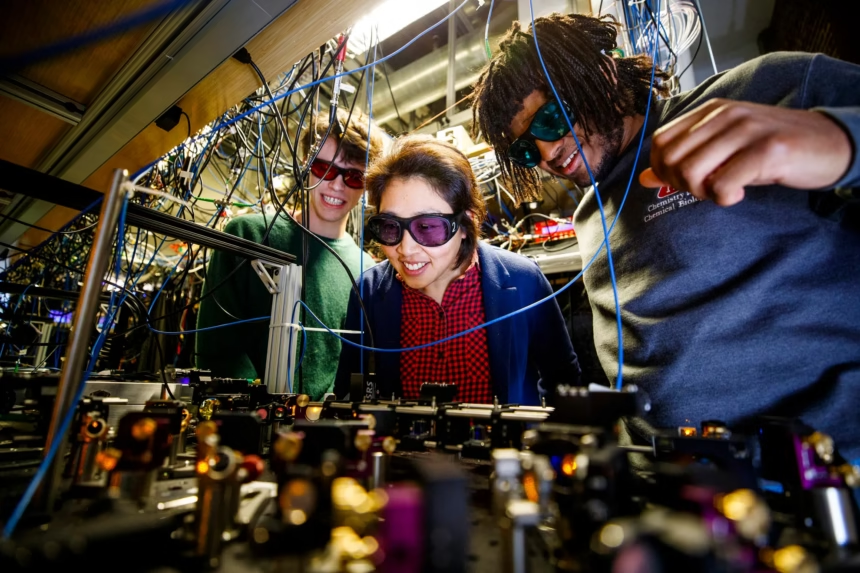2025 is turning into a turning point year for Quantum Computing Advances. For the first time, we are seeing real systems, real algorithms, and real money all lining up in the same direction. Big names like Google, Harvard, NIST, and the SQMS center are reporting landmark results.
Google’s new Quantum Echoes result on its Willow chip shows massive speedups. Research teams are keeping quantum processors stable for longer periods. Qubits are getting tougher and less noisy. Governments and tech giants are pouring in billions, not just for research, but for security and national strategy.
In this post, you will see what is actually happening, why it matters for normal people, and what the next 1 to 10 years might look like. You will also see the risks, such as broken encryption, and how countries and companies plan to stay safe.
Quantum Computing Advances in 2025: Why This Year Feels Different
For years, quantum computing sounded like science fiction. Now it feels much closer to normal science.
A quantum computer works with units called qubits. A normal computer bit is either 0 or 1. A qubit can be 0, 1, or a mix of both at the same time, due to a property called superposition. When you link qubits together and measure them, you can explore many possible answers at once, instead of one at a time.
In the early days, the race was all about more qubits. A bigger chip looked better on slides and press releases. In 2025, the focus has shifted. Researchers now care more about:
- How stable each qubit is
- How long does it keep its quantum state
- How noisy or error‑prone the chip is
- Whether it can solve a real problem, not just a toy puzzle
This change in focus makes a big difference. It signals that we are moving from “someday this might work” to “we can start using this now for certain tasks.”
Big tech companies are driving much of this progress. Google, IBM, Microsoft, and Amazon all offer access to quantum devices over the cloud. Top universities such as Harvard, Oxford, and UC Riverside are pushing science and engineering forward. Government labs and national centers support long term projects on better qubits and quantum computing.
Quantum computing is still early, but 2025 feels like the moment where it steps out of the lab and into early, practical use.
From lab experiments to usable quantum systems
The first quantum computers were fragile lab toys. They ran for tiny fractions of a second, then fell apart under noise and tiny vibrations. Running any useful program felt like trying to write an essay while the paper kept catching fire.
In 2025, that picture is changing. Qubits still do not last forever, but researchers have learned how to:
- Cool chips more carefully
- Shield them from noise
- Calibrate them automatically
- Run longer experiments without constant resets
Harvard researchers and others are reporting quantum processors that stay stable enough to run workloads for hours in a lab environment, with repeated cycles of operations and measurements. That does not mean one single qubit stays perfect for hours. It means the whole system can keep performing meaningful work without constant manual fixes.
You can think of it like taking a photo. Early quantum computers were like cameras that only allowed a ssplit-secondblurry snapshot. Now the “camera” can stay steady for longer, so you can take a much clearer picture, or even a whole sequence of shots.
These systems are already available through cloud platforms, so businesses, students, and researchers can test their own ideas on real quantum hardware. The machines are still small and noisy, but they are usable.
Who is leading the race in Quantum Computing Advances?
No single player owns the field yet. Different groups are trying different paths:
- Google: The Willow superconducting chip and the Quantum Echoes algorithm, with a strong focus on error correction and real quantum advantage.
- IBM: A long-term roadmap, steady growth in qubit counts, and frequent updates to its cloud hardware and software tools.
- Microsoft and Amazon: CCloud-based access to many quantum devices from partners, plus Microsoft’s own topological qubit efforts.
- Research labs: NIST, the SQMS center, Harvard, Oxford, UC Riverside, and many others are exploring new qubit types and quantum networks.
Startups are also very active. In 2025, quantum startups have raised billions of dollars worldwide from investors who believe that real value is coming. Some focus on superconducting qubits, some on trapped ions, some on photonic systems that use light instead of electrical signals.
Each approach has tradeoffs. Some are faster, some are more stable, some are easier to manufacture. That is why it is too early to say who has “won.”
Why Quantum Computing Advances matter beyond the hype
Quantum computers will not replace your laptop or your phone. They are more like special scientific tools that handle very hard problems, the kind that bring normal supercomputers to their knees.
These problems include:
- Simulating molecules and chemical reactions
- Optimizing complex systems, like supply chains or traffic
- Certain tasks in AI and machine learning
- Searching through huge numbers of possible solutions
If Quantum Computing Advances continue at the current pace, they can affect:
- Medicine, through faster drug discovery and better understanding of how molecules behave
- Climate and energy, through better simulations and new materials
- Finance, through sharper risk models and faster optimization
- Cybersecurity, through both new risks and new defenses
This technology will shape industries and jobs over the next decade. Even if you never touch a quantum chip, the decisions made with its help could affect your health care, your bank account, the energy you use, and the security of your data.
Breakthrough Quantum Computing Advances Making Headlines in 2025
Here are some of the most important breakthroughs that are drawing attention this year, explained in plain language.
Longer-running quantum processors: Harvard pushes past seconds into hours
A key idea in quantum computing is coherence. Coherence means how long a qubit keeps its quantum state intact before noise ruins it.
Early qubits lost coherence almost instantly. It was like trying to finish a long test while your pencil vanished after one second. You could not write enough to solve anything meaningful.
Harvard led work on quantum processors that can stay calibrated and stable through hours of experiments. Engineers designed systems that can:
- Keep qubits at the right temperature
- Constantly monitor and adjust control signals
- Run long sequences of operations without full resets
The qubits themselves still have limited coherence times, but the overall system can keep running long jobs in a controlled way. This lets researchers try bigger algorithms, test error correction over longer periods, and explore more complex physics.
For real-world scenarios, longer runtimes are essential. Useful algorithms often need many steps. Without enough time, you never finish the “test” before your “pencil” disappears.
Google’s Willow chip and Quantum Echoes: 13,000 times faster than supercomputers
Google’s Willow chip and the Quantum Echoes algorithm are among the clearest signs that Quantum Computing Advances are reaching a new level.
Here is what happened:
- Willow has 105 superconducting qubits.
- Using Quantum Echoes, Google solved a complex physics problem about how information spreads in a quantum system.
- The world’s best supercomputer would have needed around three years for the same task.
- Willow finished in a bit over two hours, about 13,000 times faster.
Quantum Echoes works like a clever “time rewind.” First, the system runs a series of quantum operations. Then the team slightly disturbs one qubit and runs the operations in reverse. By watching how that tiny change spreads, they learn how the system behaves, something that is very hard for classical computers to track.
The key point is that this task is verifiable. Other quantum systems, and even limited classical checks, can confirm that the answer is correct. That gives confidence that the speedup is real, not a trick.
This kind of advantage can help in:
- Chemistry, by modeling how molecules behave under different conditions
- Materials science, by studying quantum effects inside new materials
- Battery and drug design, by exploring many more options in the same amount of time
It does not mean quantum computers are faster at everything. It does show that for some useful problems, they already beat supercomputers by a wide margin.
Stronger qubits: NIST and SQMS boost coherence to 0.6 milliseconds
NIST and the SQMS center have focused on making individual qubits better, not just more numerous. They reported superconducting qubits with coherence times around 0.6 milliseconds.
That sounds tiny, but in quantum computing, it is a big deal. Many operations happen in nanoseconds, so 0.6 milliseconds gives room for thousands of quantum steps.
Think of a worker who keeps getting interrupted. If they only have one second before someone bothers them, they barely start the task. Give them 60 seconds, and they can get a lot done. Longer coherence is the same idea. You get more time to run a longer “program” before the qubit forgets what it was doing.
Better coherence:
- LLet’syou run deeper quantum circuits with more steps
- Reduces the number of errors mid‑calculation
- Makes error correction codes more effective
With more time to detect and correct mistakes, you can build more reliable logical qubits out of many physical qubits. Logical qubits are the building blocks needed for large-scale, practical quantum computers.
Connecting quantum computers: Oxford and UC Riverside build the quantum network
Another promising track in 2025 is quantum networking.
Researchers at Oxford are using entanglement to link distant quantum processors. Entanglement is a strange quantum link between particles, where measuring one affects the other, even if they are far apart. By creating pairs of entangled photons or ions, you can create a channel that connects separate quantum devices.
UC Riverside has been studying how to send quantum information over channels that are much noisier than the processors themselves, sometimes around ten times noisier in experiments. The goal is to show that even imperfect fiber cables or wireless links can still carry useful quantum data if you use the right tricks and error correction.
A quantum network or future “quantum internet” could:
- Link many small quantum computers into one large virtual machine
- Allow very secure communication, where any eavesdropping attempt is detectable
- Distribute entangled states across cities or even continents
It is still early, similar to connecting a few laboratory computers in the early days of the classical internet. But it marks a shift from building single machines to thinking about systems of machines.
Quantum error correction: beating noise so quantum wins in the real world
Quantum systems are extremely sensitive. Heat, vibration, or tiny electrical noise can ruin a calculation. That is why quantum error correction is so important.
Error correction does not magically fix one perfect qubit. Instead, it groups many physical qubits to they act like one more reliable logical qubit. The group uses smart patterns and “voting” to detect and correct mistakes.
You can picture a team working on a report. If one person makes a typo, the others catch it in review. As long as too many people no not make the same mistake, the final report is correct.
In 2024, Google showed that as it added more qubits under an error correction code on its earlier processors, the overall error rate went down, not up. With Willow, it continued to push below key error thresholds, proving that building bigger, more reliable systems is possible.
In 2025, many groups are refining these codes and testing them on better hardware. Error correction is one of the main keys that will turn fragile lab devices into serious tools for science and industry.
How Quantum Computing Advances Could Change Daily Life, Business, and Security
The news is exciting, but people often ask: “So what does this mean for me?” Here is how these advances could touch real life over the next decade.
Medicine and chemistry: faster drug discovery and smarter treatments
One of the brightest use cases for Quantum Computing Advances is chemistry and medicine.
Molecules act according to quantum physics. Normal computers can only approximate this behavior, and the cost grows fast as you add more atoms. Quantum computers, in principle, can model molecules more naturally.
Researchers have already used quantum systems to study molecules with around 15 to 28 atoms, which is large enough to be meaningful. As hardware improves, they can tackle more complex drug candidates and protein fragments.
This can help by:
- Screening more drug options in less time
- Predicting side effects earlier in the process
- Designing new materials for vaccines, medicines, and sensors
It will not make new medicines appear overnight. Drug trials, safety checks, and regulations still take years. But if quantum tools cut early design time from years to months, or from months to weeks, that can speed up the whole pipeline and reduce cost.
Climate, energy, and materials: solving problems too big for normal computers
Quantum computers could help with some of the hardest problems in climate and energy.
Examples include:
- Modeling how greenhouse gases behave in the atmosphere
- Designing better catalysts for clean fuel
- Finding new materials for lighter cars or stronger wind turbine blades
- Searching for better battery chemistries that charge faster and last longer
Picture a company that wants a new battery for electric cars. There might be millions of possible material combinations. A normal computer cannot explore them all in detail. A quantum computer, combined with AI and classical supercomputers, could search this space much more efficiently and point scientists to the best candidates.
Experts expect that within the next 5 to 10 years, quantum tools will start to contribute to climate and energy projects in limited but useful ways, such as narrowing design choices or testing tricky physical models.
AI and robotics: quantum power for smarter algorithms
AI and quantum are starting to help each other.
On one side, AI helps control quantum hardware. Machine learning models can tune qubit signals, spot patterns in noise, and design better quantum circuits. This makes the hardware more stable and efficient.
On the other side, quantum computers might one day speed up some AI tasks, such as:
- Searching large solution spaces for the best model settings
- Solving certain optimization problems inside learning algorithms
- Handling special kinds of data that match quantum structures
In robotics, future quantum-enhanced sensors could measure tiny changes in gravity, magnetic fields, or time. Robots with such sensors could map underground structures, improve navigation, or explore harsh environments more safely.
Most AI today still runs on GPUs and classical hardware. Quantum AI is a growing research area, not yet a daily tool. But progress in 2025 suggests the two fields will keep getting closer.
Security and encryption: risks, quantum-safe crypto, and a global race
Security is where Quantum Computing Advances bring both promise and danger.
Many of today’s encryption systems, such as RSA and ECC, rely on math problems that are hard for normal computers. A powerful future quantum computer could solve those problems much faster, which would break many current security systems.
That could expose:
- Bank and payment data
- Medical records
- Private messages and emails
- Government and military secrets
To prepare, researchers are building post-quantum or quantum-safe encryption algorithms. These are designed to stay secure even if attackers have large quantum computers.
Standards groups, including NIST, are selecting and publishing new algorithms that should protect data through 2035 and beyond. Governments and companies know that upgrading all their systems takes many years. They are starting now, long before large quantum machines exist, to avoid a future rush.
This security angle is one reason countries treat quantum computing as a strategic priority and fund it heavily. It is not just about faster science; it is also about who controls the keys to secure communication.
Jobs, skills, and the quantum-ready workforce
Quantum computing will change jobs, not just for physicists, but across many fields.
We will need:
- Software engineers who can write and test quantum algorithms
- Cloud specialists who integrate quantum hardware into data centers
- Cybersecurity experts who deploy quantum-safe encryption
- Educators and communicators who explain quantum ideas in plain language
Young readers who are curious about this field do not need to master advanced physics right away. Useful skills include:
- Solid math basics, especially algebra and probability
- Logical thinking and problem-solving
- Coding in languages like Pyproblem-solvingrking with data, and debugging programs
By 2035, many roles in finance, logistics, health care, and security may use quantum tools somewhere in their workflow. Even if you never program a quantum chip, understanding the basics can make you more “quantum-ready” in your career.
What Comes Next for Quantum Computing Advances in the Next 1 to 10 Years
So, where do Quantum Computing Advances go from here? The next decade will likely be lit into two phases: near-term pilots and longer-term. The next 1 to 3 years: quantum in the cloud and early real-world pilots.
In the short term, almost nobody will own a quantum computer at home or in their office. Instead, they will use quantum resources through the cloud.
Companies like IBM, Google, Microsoft, and Amazon already let users:
- Sign up for access to small and medium quantum processors
- Run experiments through web consoles or APIs
- Mix quantum steps into classical workflows
In the next 1 to 3 years, expect:
- More stable devices with dozens to a few hundred qubits
- Better software tools and higher-level libraries
- Early pilots in banking, logistics, pharma, and materials research
These pilots will not replace classical systems. They will run side by side, comparing quantum results to traditional methods and looking for clear advantages. Developers will find it easier to experiment without needing a PhD in physics.
The next 5 to 10 years: toward useful, large-scale quantum advantage
Looking ahead 5 to 10 years, the picture becomes more ambitious, but still grounded.
If current trends continue, we can expect:
- Improved error correction, with more logical qubits available
- Longer coherence times, so deeper quantum circuits are possible
- Early quantum networks that link processors within labs or across cities
Market forecasts suggest that quantum computing and related services could reach tens of billions of dollars by the mimid-2030swith some estimates around $97 billion by 2035 when you include hardware, software, and services.
During this period, real quantum advantage may show up in areas such as:
- Logistics, for routing trucks, ships, and planes more efficiently
- Finance, for complex risk modeling and portfolio optimization
- Climate and energy, for high fidelity simulations and material desihigh-fidelitytiming is uncertain. Progress does not happen in a straight line. But it is safer to view quantum computing as a long-term transformation, not a quick gadget upgrade.
How to stay informed on Quantum Computing Advances without getting lost
Quantum news can feel confusing. Headlines jump between “quantum is useless” and “quantum will change everything.” The truth is in the middle.
Here are simple ways to stay informed:
- Follow updates from major cloud providers like IBM, Google, Microsoft, and Amazon
- Keep an eye on announcements from leading universities and labs
- Read tech news that shows real benchmarks and compares results, not just bold claims
- Watch for progress in error rates, coherence times, and logical qubits
- Pay attention to security updates about quantum-safe encryption
You can also track news about AI and high-performance computing, since those areas often connect to quantum projects. Over time, you will start to see patterns and understand which advances matter most.
Conclusion
2025 is a standout year for Quantum Computing Advances. We see longer-running processors, better qubits, clearer quantum advantage in specific tasks, and early steps toward quantum networks. At the same time, error correction and quantum-safe security are moving forward, so these systems can work in the real world.
These shifts touch much more than science labs. They point toward new tools for medicine, climate research, finance, AI, and cybersecurity, and they signal new skills and jobs for the next generation. You do not need to understand every equation to follow the main story and make smart choices about your career or business.
Quantum computing is moving from theory to practice, powered by human creativity, smarter AI tools, and global collaboration. The next wave of breakthroughs will likely build on what we see in 2025. Stay curious, keep an open mind, and watch how this quiet revolution in computing unfolds over the coming decade.















